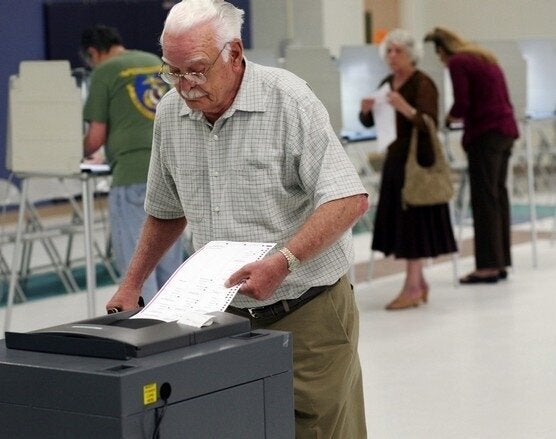
RALEIGH, N.C. -- "I was sure I voted for president, but then a friend told me that a straight-party vote in North Carolina includes every office except president. That made me really mad," Linda Chavis told OffTheBus.
Politically speaking, Chavis didn't just fall off the turnip truck. She is a volunteer "crew chief" for the Obama campaign in Raleigh who did not notice the separation between the straight-party vote and the presidential vote on North Carolina's poorly designed ballot in 2004. "I thought I voted against George W. Bush, but it turned out I didn't vote for president at all. It's an issue today because we're still using the same confusing ballot," said Chavis.
 Chavis wasn't the only dumbfounded voter in 2004. A Duke University researcher estimated that more than 90,000 people who voted in North Carolina inexplicably did not cast a vote for president. That's 60,000 to 70,000 more than researchers would expect.
Chavis wasn't the only dumbfounded voter in 2004. A Duke University researcher estimated that more than 90,000 people who voted in North Carolina inexplicably did not cast a vote for president. That's 60,000 to 70,000 more than researchers would expect.
"One way to measure the impact of ballot design on voter confusion is the Residual Vote Rate. That's the difference between the number of ballots cast and the number of valid votes for president cast," said David C. Kimball, a political science professor at the University of Missouri-St. Louis. In the last two presidential elections, the number of lost votes for president was "about twice as high in North Carolina as the national average," Kimball told OffTheBus.
"I would guess that most -- if not all -- of this difference can be attributed to North Carolina's confusing ballot," said Lawrence Norden, an attorney at the Brennan Center for Justice at the New York University School of Law. In North Carolina, a straight-party vote counter-intuitively does not include a vote for president. Voters must make a separate mark under the Presidential Contest box.
On Election Day 2008, there will probably be more voters than there were in 2004, and many of them will be first-time voters. "I believe as many as 100,000 votes for president could be lost this time around," Norden told OffTheBus.
This year's butterfly ballot?
It is important that ballots are easy to understand. Remember what happened with the butterfly ballot in Florida? When just a couple of hundred votes (out of 5.8 million cast) separated George W. Bush and Al Gore?
The ballot design flaw disproportionately impacts three groups who are likely to be heavily represented in the election this year: new voters, the poor, and the elderly. On the internet, poll workers in the Tar Heel State have "twittered" for help in explaining the ballot on election day. Some less sympathetic bloggers have replied that if people can't understand the ballot, they shouldn't be voting.
"Elections are held to get instructions from the public, they are not literacy tests," said Norden. "If something confuses people and it can easily be fixed, then it should be."
Think of it this way. "Imagine if confusing road signs were causing traffic accidents. Sure, a few people might say, 'What's wrong with those new drivers, those elderly drivers -- why can't they figure out the signs?' But before there were more fatalities, surely the government would replace the confusing signs with symbols that people can easily understand," said Norden.
Early voting started a week ago, already there are problems
"We've already had reports that people don't understand the ballot instructions," a Democratic Campaign official in North Carolina told OffTheBus. Speaking off the record, he said that the Board of Elections is "supposed to be educating voters at the polls, but so far the results are uneven. The word's not getting out consistently. Simply handing out a blue piece of paper isn't all that effective."
Adding to voter confusion, the GOP intends to challenge the legality of certain new voter registrations on Election Day, something they are already doing in Ohio. "This year I think we're going to see more first-time voters -- young people and minorities -- than ever before, and as first-time voters, they are likely to be challenged," sociologist Wayne Baker, a professor at the University of Michigan's Ross School of Business, told OffTheBus. Baker blogs the election at OurValues.org.
If two percent or more of North Carolina voters unknowingly "skip" the presidential contest, it may very well have an impact on the outcome. In 1992, George H.W. Bush narrowly defeated Bill Clinton in North Carolina by getting 43.34 percent of the vote versus 42.65 percent for Clinton. Polls indicate that this year the presidential race in North Carolina might be similarly close.
The Brennan Center recently rated North Carolina among the six best prepared states for voting system failures such as machine breakdowns and programming errors. The state's preparedness for hardware and software problems improved dramatically after their touch-screen machines failed in Carteret County in 2004 and more than 4,000 votes were lost. "I've been telling less-prepared states they don't want to become another North Carolina, waiting for a meltdown to improve their practices. And I don't want North Carolina to be another North Carolina. I hope the ballot design flaw doesn't throw the results of its presidential contest into doubt," said Norden.
VotersUnite.org recommends that people in North Carolina avoid straight-party voting.
